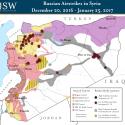 |
 |
Russian Airstrikes in Syria: December 20, 2016 – January 25, 2017

Russia shifted the focus of its air campaign from northwestern to eastern Syria from January 14 – 25 in support of pro-regime forces vying to repel a major ISIS offensive against Deir ez Zour City. Prior to the start of that offensive, however, Russia conducted aggressive air operations against opposition terrain in southern Idlib and western Aleppo Provinces from January 12 – 13, continuing to flout the nationwide ‘ceasefire’ agreement that Russia brokered with Turkey and Iran on December 28. These operations demonstrate Russia’s commitment to set conditions for pro-regime forces to clear the suburbs of Aleppo City and thereby strengthen their hold over Syria’s largest urban center. Then, on January 14, ISIS mounted an offensive against pro-regime forces in Deir ez Zour City, severing the pro-regime ground line of communication linking regime-held districts in the western half of the city to the Deir ez Zour Military Airport two days later. In response to the jihadist group’s gains, Russia conducted heavy waves of airstrikes against ISIS in Deir ez Zour City and its environs from January 14 – 17, intensifying its operations even further from January 18 – 25 amidst concerted pro-regime ground efforts to relieve the besieged airport. In support of those efforts, Russian Tu-22 strategic bombers conducted airstrikes against ISIS in Deir ez Zour Province after taking off from Russia and transiting Iraqi and Iranian airspace on January 21 and 23 – 25, according to the Russian Ministry of Defense. Meanwhile, Russian warplanes also targeted ISIS sanctuaries in eastern Homs and Hama Provinces, including the city of Palmyra. The dramatic surge in Russian airstrikes against ISIS, however, does not suggest that Russia can be a reliable partner for the U.S. against Salafi-jihadist groups. Rather, the surge reflects Russia’s strategic interest in bolstering the claim of Syrian President Bashar al Assad over all of Syria and maintaining a foothold in the Euphrates River valley from which to launch future operations into western Iraq. Although the ISIS offensive precipitated a shift in the focal point of the Russian air campaign in Syria, that shift will be a temporary one. Once militarily practicable, Russia will renew its air operations against the acceptable opposition in northwestern Syria in order to further constrain U.S. options for engagement in the Syrian Civil War.
The ISIS offensive in Deir ez Zour City coincided with a Russian Ministry of Defense announcement that Russia and Turkey conducted their first “joint air operation” against ISIS in the suburbs of al Bab in northern Aleppo Province on January 18, but Russia will not make a long-term investment in the defeat of ISIS in northern Syria, either. Russian warplanes actually began targeting al Bab and its environs in advance of the announcement, conducting airstrikes against the nearby town of Tadef on January 13 and the city itself on or around January 16 – 17. Meanwhile, the U.S.-led anti-ISIS coalition began airstrikes in support of Turkish-backed operations against ISIS in al Bab, conducting no fewer than four strikes near the city from January 16 – 17. The failure of Turkish and Turkish-backed forces to make significant gains near al Bab during this period, however, suggests that Russia will not allocate the air assets necessary to confer a decisive military advantage to the Turkish-led Operation Euphrates Shield (OES). In striking al Bab, Russia aims to exploit Turkey’s condemnation of the U.S. for failing to provide more timely support to OES and thereby exacerbate the rift between the two NATO allies, all at a minimal investment of military assets and while claiming credit for counter-terrorism operations. Russia likely also sortied strategic bombers against ISIS in Deir ez Zour Province and falsely claimed coordinated airstrikes with the U.S. against ISIS in al Bab on January 22 to highlight its ostensible value to the anti-ISIS campaign to the new U.S. administration. Whatever the effectiveness of its anti-ISIS air operations in the short-term, Russia’s reactionary response to ISIS in Deir ez Zour City and its opportunistic targeting of the jihadist group in al Bab demonstrate that Russia will prioritize its own strategic objectives over the defeat of Salafi-jihadist threats in the long run.